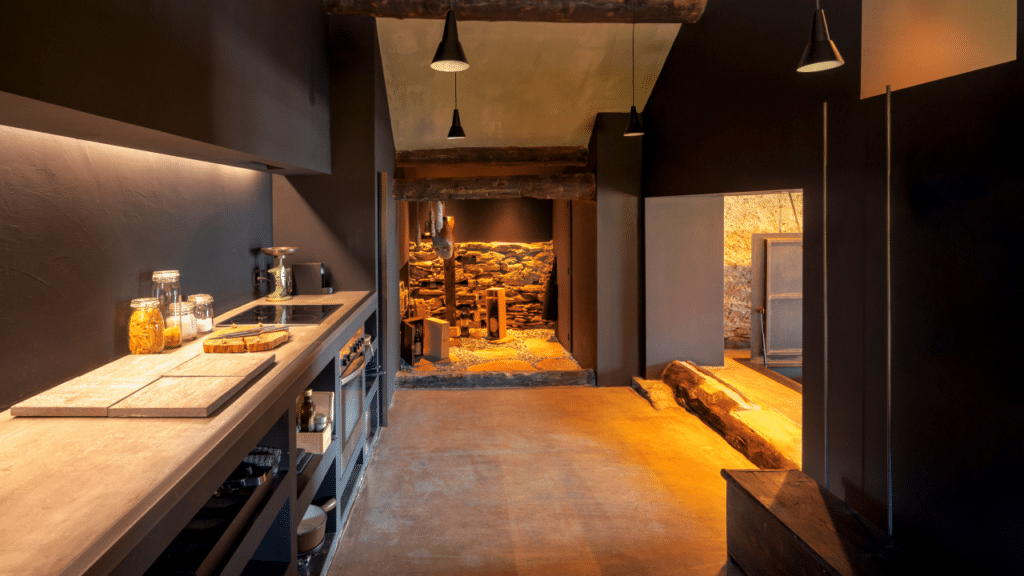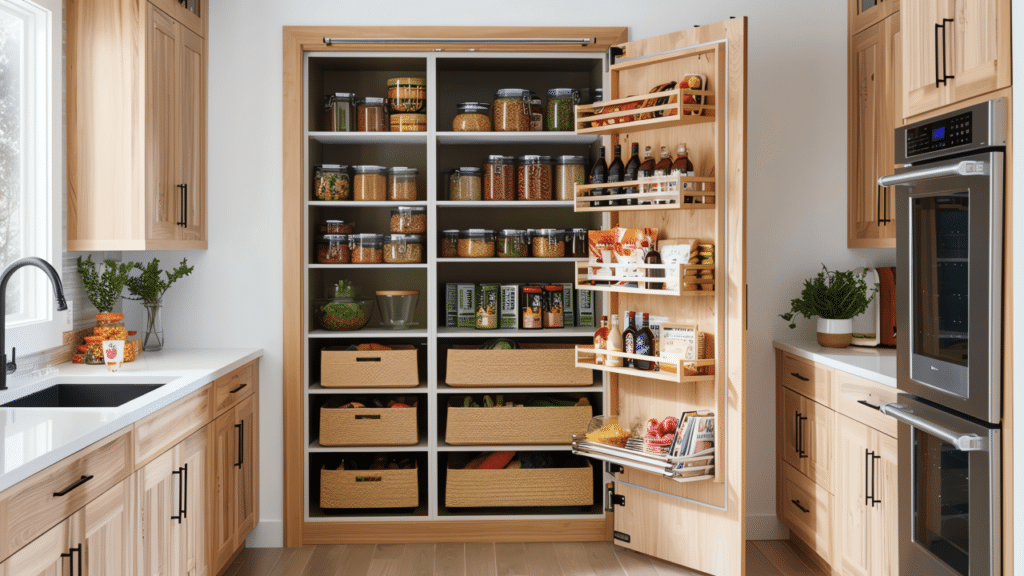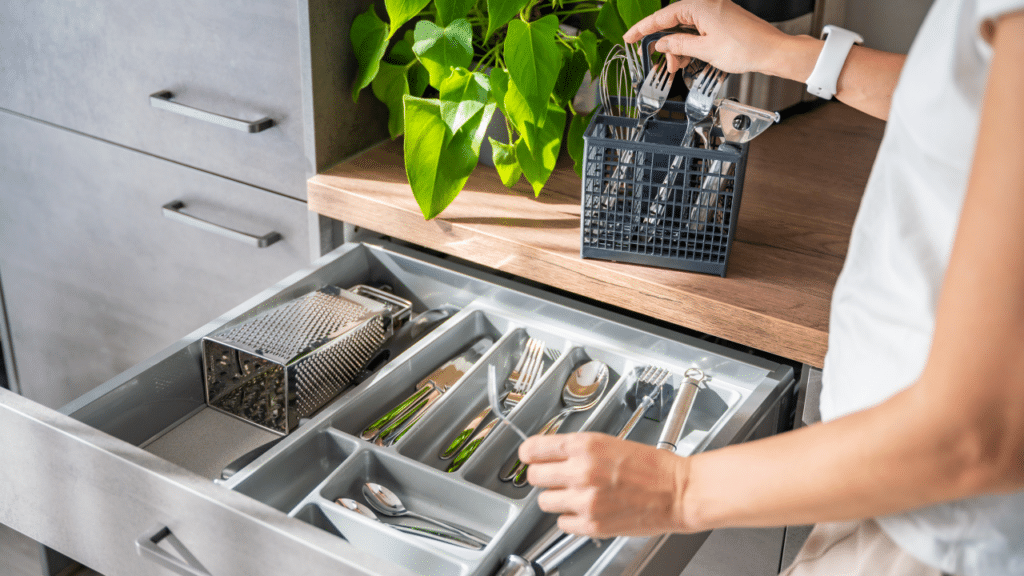A well-organised kitchen can transform cooking from a chaotic task into a far more enjoyable activity. For interior designers looking to enhance their clients’ kitchens, practical design hacks can elevate everyday life. Whether your clients are seasoned chefs or occasional home cooks, these effective kitchen design strategies can make meal preparation more efficient, enjoyable, and stress-free. Discover these easy-to-implement ideas that will help streamline kitchen spaces, boost productivity, and create functional, stylish environments for your clients:
1. Use Chalkboard Paint for Grocery Lists
Managing grocery lists and meal plans can often be a hassle, with sticky notes, apps, and random scraps of paper cluttering the kitchen. An innovative solution for interior designers is to transform a section of the kitchen wall or the inside of a cabinet with chalkboard paint. This creates a writable surface for jotting down grocery lists, structured meal plans, or reminders effortlessly.
Chalkboard paint not only adds a creative and functional element to kitchen design but also encourages family members or housemates to collaborate on the grocery list. This shared space for notes adds a personalised touch to the kitchen, making it more inviting. Get creative with this surface by writing inspirational quotes, dinner recipes, or even leaving fun doodles for others to enjoy! With innovative solutions like chalkboard paint, you can transform their kitchen into a functional and organised space that enhances their cooking experience.
Pro Tip: If your client prefers a more discreet look, consider painting the inside of a cabinet door with chalkboard paint. This allows you to maintain an organised system while keeping it hidden when guests are over
2. Enhance Kitchen Functionality with Under-Cabinet Lighting
As an interior designer, you know that good lighting is essential for any functional kitchen. Installing under-cabinet lighting is a straightforward upgrade that can significantly enhance your clients’ cooking spaces. By adding LED strip lights or puck lights beneath cabinets, you can illuminate countertops, improving visibility during food prep and elevating the overall kitchen ambiance.
This lighting solution is particularly beneficial for kitchens with limited natural light or where overhead lighting creates unwanted shadows on work surfaces. Whether your clients are chopping vegetables, reading recipes, or adding seasoning, under-cabinet lighting ensures that every detail is clearly visible.
LED strip lights are energy-efficient, easy to install, and available in various colour temperatures. You can choose bright white for task lighting or a warmer hue for a cosy, ambient glow. If you are looking for a simple yet impactful kitchen upgrade for your clients, incorporating under-cabinet lighting is a must try design hack that enhances both functionality and aesthetics.
Pro Tip: For an even more tailored lighting experience, consider installing dimmable LED lights. This allows your clients to adjust the brightness according to their needs—bright for detailed tasks like cooking and softer for creating a relaxing atmosphere during dinner parties

3. Maximise Kitchen Space by Utilising Cabinet Doors for Extra Storage
One of the simplest yet often overlooked interior design opportunities to enhance kitchen functionality lies within the cabinet doors. By installing hooks, baskets, or slim shelves on the inside of cabinet doors, you can create valuable extra storage for small items like spices, measuring spoons, or cleaning supplies. This design hack is especially beneficial in small compact kitchens where countertop space is minimal, allowing you to make the most of every square inch.
To implement this solution, start by attaching adhesive hooks to hold measuring spoons or small utensils, or mount narrow racks specifically for spice jars. You can consider placing a basket on the cabinet door to hold cling film, foil, or sandwich bags. The key is to keep frequently used items easily accessible without cluttering the kitchen workspace.
This approach not only maximises storage space but also enhances kitchen organisation, ensuring that your clients can quickly find what they need while cooking.
Pro Tip: Encourage your clients to personalise their cabinet door storage by using clear containers or labelled baskets. This not only keeps items organised but also adds a decorative element to their kitchen, making it both functional and visually appealing.

4. Enhance Kitchen Organisation with a Lazy Susan in the Fridge!
As an interior designer, you understand that maximising efficiency in the kitchen is key to a great cooking experience. A Lazy Susan is a fantastic solution for tackling the challenge of reaching ingredients at the back of the fridge, which can often feel like a game of Tetris. Incorporating a Lazy Susan on a fridge shelf makes it simple to rotate and access items without the hassle of rearranging everything, helping to reduce food waste by keeping ingredients visible and accessible.
Lazy Susans are particularly effective for organising small jars, condiments, and sauces that often get pushed to the back of the fridge and forgotten. This simple addition can significantly enhance storage and consumption of food, encouraging better organisation and reducing the chances of items expiring before they are used.
Pro Tip: For clients concerned about spills, you can recommend a Lazy Susan with a raised lip or edge. This design feature helps contain messes, making it even easier to maintain a clean and organised refrigerator.
5. Adjustable Drawer Dividers for Utensils
A cluttered drawer filled with utensils and cooking tools can disrupt your clients’ cooking process and lead to unnecessary frustration. As an interior designer, you can help by installing adjustable drawer dividers to keep everything meticulously organised, making it easier for your clients to quickly find what they need. Drawer dividers not only minimise clutter but also ensure that essential items like knives, spatulas, and whisks have their own designated spots.
You can customise the dividers to fit specific drawer dimensions and accommodate various utensil sizes, providing a tailored solution for your clients’ kitchens. A well-organised drawer enhances cooking flow, allowing your clients to concentrate on meal preparation instead of rummaging through a jumbled mess to find the right tool.
Pro Tip: Encourage your clients to group utensils by category, such as cutlery, cooking tools, and specialty gadgets. This organisation method not only saves time but also creates a visually appealing layout, elevating the overall design of the kitchen.

To wrap up the kitchen hacks we have explored: Incorporating these quick and simple kitchen hacks can significantly elevate your clients’ home living by effectively transforming their cooking spaces into organised and functional environments. By utilising these practical design strategies, you not only enhance the aesthetics of their kitchens but also improve their overall cooking experience, making meal preparation more enjoyable and stress-free. As an interior designer, your ability to provide innovative solutions will ensure your clients appreciate the thoughtful details that make a kitchen truly exceptional.
Ready to take your design skills to the next level?
Explore our wide range of accredited interior design courses today, including short courses, diplomas, undergraduate degrees, and a master’s degree in interior design. Whether you are looking to deepen your knowledge or gain new industry insights, our programs empower you to create stunning, functional spaces that your clients will love!
At NDA, flexibility is key. You can study at a time that suits you, making it easier to fit your education around your lifestyle and everyday commitments. We also offer affordable tuition without compromising on quality, and our experienced tutors provide personalised support to guide you through every step of your studies. Plus, with clear progression pathways, you can easily advance from a diploma to a degree and even a master’s program, all within a supportive learning environment.
Our courses meet the highest academic standards, with diplomas accredited by AIM Qualifications Awards and degrees validated by partners like De Montfort University, Leicester. This ensures your qualification is recognised globally and opens doors to future academic and professional opportunities.
Start Your Design Journey Today
At NDA, we believe education should inspire and transform lives.
Join us to discover how studying with NDA offers a unique and transformative opportunity in the world of design education.

